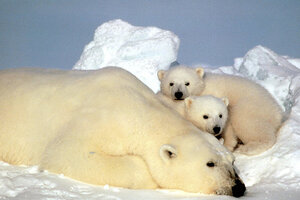Polar bears now take longer, perilous swims to find habitable ice
As sea ice disappears, particularly in the Beaufort Sea on Alaska's northern coast, a new study finds polar bears are swimming increasingly long distances, often perilous ones, to find habitable ice.

This undated file photo released by the U.S. Fish and Wildlife Service shows a sow polar bear resting with her cubs on the pack ice in the Beaufort Sea in northern Alaska. A new study finds disappearing sea ice in the region is forcing polar bears to make increasingly long swims, which can be dangerous, to find habitable ice.
Steve Amstrup/US Fish and Wildlife Service via AP/File
Scientists have long warned about the dangers global warming could pose to polar bears, noting that greenhouse gas emissions can accelerate the disappearance of Arctic sea ice that many polar bears depend on to survive.
Now, they've learned more about how polar bears are attempting to deal with the changing conditions: by making long, increasingly perilous swims, sometimes hundreds of miles long, to reach habitable ice.
Polar bears have increasingly become a symbol of the fight to curb global warming, with two-thirds of the population expected to disappear by 2050, according to the US Geological Survey.
100 bears tracked with GPS collars off the northern coasts of Alaska and Canada made a total of 115 swims greater than 31 miles in length, according to a study recently published in the journal Ecography.
"Ice is changing so quickly that we're finding the bears are getting caught in places where they're finally coming to the realization, 'I just can't stay here,'" Andrew Derocher, a researcher at the University of Alberta who co-authored the study, told the Washington Post. "These kinds of long-distance swims are not what they evolved to undergo."
Polar bears are good swimmers, but they can only travel at about 2 kilometers an hour. The long journeys can prove highly taxing, causing adults to lose weight, and potentially exposing their cubs to hypothermia.
The study finds that in 2004, only a quarter of the bears monitored made a long-distance swim of over 50 kilometers, or about 31 miles. But by 2012, 69 percent of the bears were making such a swim, an increase Dr. Derocher says is proportional to the loss of sea ice in the area.
One female polar bear began her journey in the Beaufort Sea in September 2009, swimming continuously for nine days without food or rest. To reach a large enough slab of sea ice, she swam some 250 miles, the longest journey of any of the bears.
To protect their cubs, mothers with offspring will instead walk hundreds of kilometers to keep their cubs out of the frigid water, Derocher told The Post.
Global warming appears to have greatly eroded the ice, which polar bears use as a platform from which to dive for seals and other prey.
When Derocher began studying polar bears in the 1980s, making a long distance swim would be unusual for any bear, the professor told The Post. That's because the Beaufort Sea and the Hudson Bay, where the researchers studied the bears, were covered with ice even during the summer.
Now sea ice has declined, particularly in the the Beaufort Sea above Alaska and the Yukon, according to recent satellite images.
Conservationists have launched a variety of efforts to save polar bears, which were declared an endangered species in 2008. One effort, created as part of the US Fish and Wildlife Service's Polar Bear Recovery plan, would protect 187,000 square miles of Alaska’s northern coast.
In March, a federal appeals court endorsed the plan, overriding a challenge by the state of Alaska; oil and gas industries; some lawmakers, including Sen. Lisa Murkowski (R) of Alaska; and local indigenous groups, which argued that the agency had overreached by protecting such a vast area.
The federal agency had argued that protecting the waters was necessary because polar bears are highly mobile, traveling up to 50 miles inland.
The 9th Circuit Court of Appeals said that the agency's "designation of polar bear habitat was not arbitrary, capricious or otherwise in contravention of applicable law."
The changing conditions could have large-scale implications for the bears' behavior, researchers say.
Increasingly, the bears may be forced to adapt to the loss of sea by hunting on land during the summers, as some polar bears who live in the Hudson Bay currently do.
"None of this is what I would call a smoking gun as to what is happening with polar bear abundance, but the signs are all pointing in the same direction," Derocher, the University of Alberta researcher, told The Post. "We're seeing bears with lower body fat, fewer cubs, changing hunting behavior."

